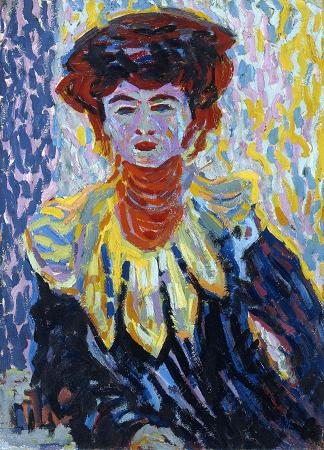Ernst Ludwig Kirchner (1880 - 1938). Ernst Ludwig Kirchner was a German expressionist painter and printmaker and one of the founders of the artists group Die Brücke or The Bridge, a key group leading to the foundation of Expressionism in 20th-century art. He volunteered for army service in the First World War, but soon suffered a breakdown and was discharged. In 1933, his work was branded as degenerate by the Nazis and in 1937, over 600 of his works were sold or destroyed. In 1938, he committed suicide by gunshot. Ernst Ludwig Kirchner was born in Aschaffenburg, Bavaria. His parents were of Prussian descent and his mother was a descendant of the Huguenots, a fact to which Kirchner often referred. As Kirchner's father searched for a job, the family moved frequently and Kirchner attended schools in Frankfurt and Perlen until his father earned the position of Professor of Paper Sciences at the College of technology in Chemnitz, where Kirchner attended secondary school. Although Kirchner's parents encouraged his artistic career they also wanted him to complete his formal education so in 1901, he began studying architecture at the Königliche Technische Hochschule of Dresden. The institution provided a wide range of studies in addition to architecture, such as freehand drawing, perspective drawing and the historical study of art. While in attendance, he became close friends with Fritz Bleyl, whom Kirchner met during the first term. They discussed art together and also studied nature, having a radical outlook in common. Kirchner continued studies in Munich from 1903 to 1904, returning to Dresden in 1905 to complete his degree. In 1905, Kirchner, along with Bleyl and two other architecture students, Karl Schmidt-Rottluff and Erich Heckel, founded the artists group Die Brücke. From then on, he committed himself to art. The group aimed to eschew the prevalent traditional academic style and find a new mode of artistic expression, which would form a bridge between the past and the present. They responded both to past artists such as Albrecht Dürer, Matthias Grünewald and Lucas Cranach the Elder, as well as contemporary international avant-garde movements. As part of the affirmation of their national heritage, they revived older media, particularly woodcut prints. Their group was one of the seminal ones which in due course had a major impact on the evolution of modern art in the 20th century and created the style of Expressionism. The group met initially in Kirchner's first studio, which had previously been a butcher's shop. Bleyl described it as that of a real bohemian, full of paintings lying all over the place, drawings, books and artist's materials, much more like an artist's romantic lodgings than the home of a well-organised architecture student. Kirchner's studio became a venue which overthrew social conventions to allow casual love-making and frequent nudity. Group life-drawing sessions took place using models from the social circle, rather than professionals, and choosing quarter-hour poses to encourage spontaneity. Bleyl described one such model, Isabella, a fifteen-year-old girl from the neighbourhood, as a very lively, beautifully built, joyous individual, without any deformation caused by the silly fashion of the corset and completely suitable to our artistic demands, especially in the blossoming condition of her girlish buds. A group manifesto written by Kirchner in 1906 stated that Everyone who reproduces, directly and without illusion, whatever he senses the urge to create, belongs to us. In September and October 1906, the first group exhibition was held, focused on the female nude, in the showroom of K.F.M. Seifert and Co. in Dresden. In 1906, he met Doris Große, who was his favoured model until 1911. Between 1907 and 1911, he stayed during the summer at the Moritzburg lakes and on the island of Fehmarn with other Brücke members; his work featured the female nude in natural settings. In 1911, he moved to Berlin, where he founded a private art school, MIUM-Institut, in collaboration with Max Pechstein with the aim of promulgating Moderner Unterricht im Malen. This was not a success and closed the following year, when he also began a relationship with Erna Schilling that lasted the rest of his life. In 1913, his writing of Chronik der Brücke led to the ending of the group. At this time, he established an individual identity with his first solo exhibition, which took place at the Essen Folkwang Museum. During the next two years, he painted a series of Straßenszenen showing the streets of Berlin, with the central characters of street walkers. At the onset of the First World War in September 1914, Kirchner volunteered for military service.
more...














